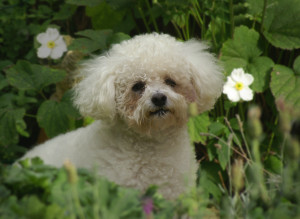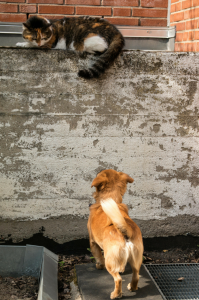Which Dogs Are Good with Cats?
There are many types of dogs that get along very well with cats and, although some may not be reliable with neighbourhood pets outside the home, lots do get on with ones living in the same household – especially if they are brought up together. Holidays4Dogs looks into some of the breeds that are particularly suitable for living with pet cats. We also provide a few simple tips on how to introduce dogs and cats together.
In Britain, 46 per cent of households have pets and a quarter of those have dogs. However, many dog owners also keep cats, as well as dogs and, while one may think of the old saying, “fighting like cats and dogs” – this doesn’t always have to be the case. There are some breeds of dog more likely to accept felines – or other small pets as their house-mates, than others. Here are a few suggestions;-
Bichon Frise.
These sociable and happy little dogs generally get along very well with cats. They are fairly undemanding in terms of exercise and will happily regard a cat in the home as another little playmate.
They are fairly undemanding in terms of exercise and will happily regard a cat in the home as another little playmate.
Bichons are fun little dogs to have around and most cats, except for the very shy ones, won’t be too offended by having to share their home with a little bundle of fluff.
Golden Retrievers.
Golden retrievers generally make good all round family pets. They are usually gentle and polite, despite their size. In addition, they are usually easy to train, especially when it comes to introductions with feline companions.
Papillon.
These delicate little dogs make great friends for cats. They are small enough not be a threat to even the most timid of cats and they love company, whether it be human, canine or feline.
Pug.
Another happy-go-lucky little fellow who is super friendly with everyone. They are little power houses when they want to be, so some cats may not appreciate them being quite so friendly all the time. Broadly speaking, however, pugs are sociable and non-confrontational.
Newfoundland.
Despite their stature, these dogs might be a great choice for a household with cats. Generally, Newfoundland’s have soft and gentle temperaments. They don’t tend to rush around too much – a trait very much appreciated by the more demure feline.
Will my dog get along with cats in the same household?
There are many dogs that get on with cats, including those generally regarded as unfriendly towards cats – collies, Siberian huskies, or jack Russell terriers, for example. Even some sight hounds, such as the greyhound, can be amicable with cats in the same household.
Introductions between the two species should always be carefully monitored. There may be situations where some dogs in the household will not tolerate the presence of a resident cat. If this is the case – it is important to make sure your cat has plenty of escape routes. It may also involve keeping the two animals in separate areas of the home.
However, many pet dogs of all breeds, will eventually learn to live with cats. While some may only tolerate the presence of cats – others will be happy to form a close attachment to their feline friends.
Introducing dogs and cats.
 When introducing dogs into the same household where cats live, or vice versa, it is important to provide a safe place for the feline – somewhere where the dog cannot access. The use of baby gates can be helpful, so the cat can jump over into another room if needs be. Place the cat’s food dishes and litter tray out of reach – ideally, in a room the dog never has access to.
When introducing dogs into the same household where cats live, or vice versa, it is important to provide a safe place for the feline – somewhere where the dog cannot access. The use of baby gates can be helpful, so the cat can jump over into another room if needs be. Place the cat’s food dishes and litter tray out of reach – ideally, in a room the dog never has access to.
Even if the cat has been used to living with dogs he, or she, will find it unsettling when a new dog is brought into the household. For the first few days, it is a good idea to keep the new cat, or dog, separate from existing pets. Set up stair gates so that the two pets can smell and see each other, but not touch.
Always put the dog on a lead for the first few days during initial introductions. Have lots of tasty treats handy for rewarding calm behaviour.
It is important not to overwhelm the household cat by forcing introductions too quickly. If things go wrong, take a few steps back and provide the pets with more space from each other.
Conclusion.
Some cat and dog introductions are hassle free and quick. Others may take time, – sometimes over several months. However, if you are patient there is a good chance they will eventually become the best of friends.


